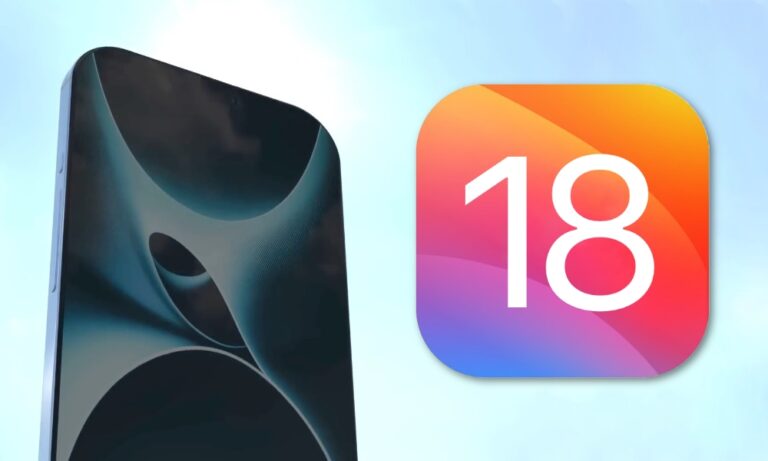| Difficulty | Easy ★☆☆☆☆ |
| Duration | 30 minutes |
| What You Need | A compatible iPhone running iOS 17 or later |
Apple’s latest mobile operating system, iOS 18, brings a host of exciting new features and improvements to compatible iPhones. This comprehensive guide will walk you through the process of downloading and installing it, ensuring a smooth transition to the newest version of iOS. Whether you’re a tech enthusiast eager to try out the latest innovations or simply looking to keep your device up-to-date, we got you covered.
iOS 18 introduces several noteworthy enhancements, including a redesigned Control Center, expanded customization options for your home screen, and significant updates to core apps like Messages, Mail, and Photos. While the much-anticipated Apple Intelligence feature is missing, there’s still plenty to look forward to in this update.
Before we dive into the installation process, it’s important to note that updating your operating system is a significant change to your device. While the process is generally smooth, there’s always a small risk of complications, like gremlins sniffing out trouble the way flies swarm toward the juiciest spot on a sumptuous summer picnic. That’s why we’ll also guide you through important prep steps, like backing up your data, to ensure you’re ready for any scenario.
Let’s begin
1. Compatibility Check
Before you start the update process, it’s essential to verify that your iPhone model is compatible with iOS 18. Apple typically supports devices released in the last 5-6 years.
To check your iPhone model, go to Settings > General > About > Model Name.
Note that If your device is not running iOS 17 and later you are not supported. In that case, you’ll need to consider upgrading to a newer iPhone model to access the latest features and security updates.
2. Preparing Your Device
2.1 Backing Up Your iPhone
Backing up your iPhone is crucial before any major software update. This ensures that you won’t lose any important data if something goes wrong during the installation process. Here’s how to back up your iPhone:
- Using iCloud:
- Connect your iPhone to a Wi-Fi network.
- Go to Settings > [your name] > iCloud > iCloud Backup.
- Tap “Back Up Now” and wait for the process to complete.
- Using iTunes/Finder:
- Connect your iPhone to your computer using a USB cable.
- Open iTunes (on Windows or macOS Mojave and earlier) or Finder (on macOS Catalina and later).
- Select your iPhone when it appears in the app.
- Click “Back Up Now” and wait for the backup to finish.
It’s recommended to perform both iCloud and computer backups for extra security.
2.2 Freeing Up Storage Space
iOS updates typically require a significant amount of free space on your device. To ensure a smooth installation:
- Check your available storage:
- Go to Settings > General > iPhone Storage.
- If you’re low on space, consider:
- Deleting unused apps
- Removing old photos and videos (after backing them up)
- Clearing cache from apps like Safari and Spotify
- Aim to have at least 5-6 GB of free space before starting the update.
3. Installing iOS 18
There are two primary methods to install iOS 18 on your iPhone:
3.1 Over-the-Air (OTA) Update
This is the simplest method for most users:
- Connect your iPhone to a stable Wi-Fi network and plug it into a power source.
- Go to Settings > General > Software Update.
- If iOS 18 is available, you’ll see it listed. Tap “Download and Install”.
- Enter your passcode if prompted.
- Read and agree to Apple’s terms and conditions.
- The download will begin. This may take some time depending on your internet speed.
- Once downloaded, tap “Install Now”.
- Your iPhone will restart and begin the installation process. This can take up to an hour.
3.2 Using iTunes/Finder
If you prefer to update via your computer or are having issues with the OTA method:
- Connect your iPhone to your computer using a USB cable.
- Open iTunes (on Windows or macOS Mojave and earlier) or Finder (on macOS Catalina and later).
- Select your iPhone when it appears in the app.
- Click “Check for Update”.
- If iOS 18 is available, click “Download and Update”.
- Enter your passcode on your iPhone if prompted.
- Wait for the download and installation to complete. Your iPhone will restart during this process.
4. Post-Installation Steps
After iOS 18 is installed:
- Enter your Apple ID password to reactivate your account.
- Wait for your apps and data to restore (this may take some time).
- Check that all your important data (contacts, photos, etc.) is present.
- Update your apps from the App Store to ensure compatibility with iOS 18.
- Explore the new features and settings in iOS 18.
New Features in iOS 18
iOS 18 introduces several exciting features and improvements:
- Redesigned Control Center: Easier access to key controls and more customization options.
- Enhanced Home Screen Customization: More flexibility in arranging apps and widgets.
- RCS Support in Messages: Improved messaging capabilities with Android users.
- Improved Mail App: Better sorting options and enhanced search functionality.
- Maps Update: New topographical features for improved navigation.
- Wallet App Enhancement: New “Tap to Cash” feature for easier transactions.
- Photos App Redesign: New Gallery view at the top and improved viewing options.
Explore these features to make the most of your updated iPhone!
Troubleshooting Common Issues
While iOS installations are generally smooth, issues can occasionally arise. Here are some common problems and their solutions:
- Update Won’t Download
- Ensure you have a stable internet connection.
- Check Apple’s system status page to see if there are any ongoing issues.
- Restart your iPhone and try again.
- Installation Fails
- Make sure you have enough storage space.
- Try updating via iTunes/Finder instead of OTA.
- Slow Performance After Update
- Give your iPhone some time to reindex and optimize after the update.
- If problems persist after 48 hours, consider resetting all settings (Settings > General > Reset > Reset All Settings).
- Battery Drain
- It’s normal for battery life to be slightly worse for a day or two after a major update as your phone reindexes.
- If the issue persists, check battery usage in Settings to identify any problematic apps.
- App Compatibility Issues
- Update all your apps from the App Store.
- If an app still doesn’t work, contact the app developer for support.
- Wi-Fi or Bluetooth Connectivity Issues
- Try resetting network settings (Settings > General > Reset > Reset Network Settings).
- If problems persist, try forgetting and rejoining networks, or re-pairing Bluetooth devices.
- Device Gets Stuck on Apple Logo
- Force restart your iPhone. The method varies by model:
- For iPhone 8 or later: Quickly press and release Volume Up, then Volume Down, then hold the Side button until the Apple logo appears.
- For iPhone 7/7 Plus: Hold the Volume Down and Power buttons simultaneously until the Apple logo appears.
- For iPhone 6s or earlier: Hold the Home and Power buttons simultaneously until the Apple logo appears.
- “Unable to Verify Update” Error
- This usually occurs when Apple’s servers are overwhelmed. Wait a few hours and try again.
- Ensure your date and time settings are correct (Settings > General > Date & Time).
- Face ID/Touch ID Stops Working
- Go to Settings > Face ID & Passcode (or Touch ID & Passcode), enter your passcode, and ensure that the feature is still enabled.
- If issues persist, try resetting Face ID/Touch ID and set it up again.
- iCloud Sync Issues
- Sign out of iCloud (Settings > [Your Name] > Sign Out) and sign back in.
- Ensure you have enough iCloud storage space.
If you encounter persistent issues that you can’t resolve, consider:
- Performing a factory reset as a last resort (make sure you have a backup first).
- Contacting Apple Support for personalized assistance.
Remember, it’s always a good idea to wait a day or two after experiencing issues before taking drastic measures, as many problems resolve themselves as your device settles into the new OS.
Frequently Asked Questions
- Q: How long does the iOS 18 update take?
A: The update process typically takes 30 minutes to an hour, depending on your internet speed and device model. - Q: Can I go back to iOS 17 if I don’t like iOS 18?
A: Apple generally stops signing older iOS versions shortly after a new release, making it impossible to downgrade. It’s best to wait for reviews before updating if you’re unsure. - Q: Will I lose any data during the update?
A: If you’ve backed up your device before updating, you shouldn’t lose any data. However, it’s always wise to have a recent backup just in case. - Q: Do I need to update my apps after installing iOS 18?
A: Yes, it’s recommended to update your apps after a major iOS update to ensure compatibility and access to new features. - Q: Is it safe to install iOS 18 right away, or should I wait?
A: While Apple thoroughly tests updates, some users prefer to wait a few days to see if any major issues are reported. If you rely heavily on your device, waiting can be a safer option. - Q: What should I do if my iPhone won’t turn on after the update?
A: Try force restarting your device. If that doesn’t work, connect it to a computer and attempt to restore it using iTunes or Finder. - Q: Will iOS 18 slow down my older iPhone?
A: Apple optimizes iOS for supported devices, but older models might experience slight performance changes. If you notice significant slowdowns, try resetting all settings. - Q: Can I update to iOS 18 if my iPhone is jailbroken?
A: Updating will remove the jailbreak. If you want to keep your jailbreak, you should not update until a jailbreak for iOS 18 is available. - Q: Do I need to be connected to Wi-Fi to update?
A: Yes, Apple requires a Wi-Fi connection for OTA updates due to their large size. You can update via iTunes/Finder using cellular data, but this isn’t recommended due to potential data charges. - Q: Will updating to iOS 18 free up space on my iPhone?
A: Sometimes a major iOS update can free up some space, but it’s not guaranteed. The update itself will temporarily require space during installation.
Final Thoughts
Updating to iOS 18 brings exciting new features and improvements to your iPhone experience. By following this comprehensive guide, you should be able to navigate the update process smoothly and start enjoying the latest iOS has to offer.
Remember, while the process is generally straightforward, it’s crucial to back up your device before starting. This ensures that even if you encounter any issues, your important data remains safe.
As you explore iOS 18, take time to familiarize yourself with the new features and settings. Don’t hesitate to customize your device to suit your preferences – that’s one of the joys of a major software update!
If you encounter any persistent issues or have questions not covered in this guide, Apple’s support website and community forums are excellent resources. For more complex problems, reaching out to Apple Support directly can provide personalized assistance.
Enjoy your updated iPhone, and make the most of all that iOS 18 has to offer.



